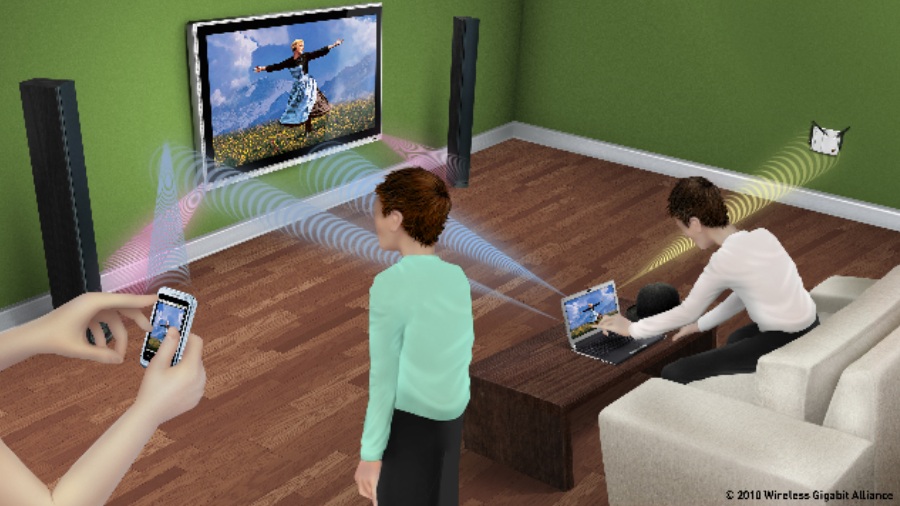Why 60 GHz WiGig is the answer to the crowded WiFi spectrum
Rescue is at hand

Victims of its own success – The Wi-Fi industry has been wildly successful and fundamentally changed the way we work and play – by enabling us to always be connected anytime, anywhere – since it hit the scene a bit more than a decade ago.
While the 2.4 GHz band is largely saturated today, it is projected that the 5 GHz band will become even more saturated within 2-3 years due to the roll out of 802.11ac.
With the internet of things in its infancy, and ready to explode, the number of network nodes is poised to experience exponential growth. With all of these omni-directional, "whole home" transmitters shouting at each other, the potential exists for the collapse in individual performance.
The industry needs a way to add capacity, and develop a technology that can be heard in the din. The promising thing is that the industry already has a solution: 802.11ad/WiGig operating in the 60 GHz band.
Since the late '90s, Wi-Fi has existed exclusively in the two license-free ISM bands below 6 GHz: 2.4 and 5 GHz. In the past decade, the 2.4 GHz band has rapidly filled with traffic from consumer Wi-Fi devices, layering on top of noise that was already there from household electronics such as baby monitors, microwave ovens and garage door openers.
While the standards were created at the same time, 5 GHz products were much slower to ramp, primarily due to cost and design complexity.
Changes afoot
This started to change with second generation .11n devices, hailed as "dual-band" (2.4/5 GHz), and will "cross the chasm" this year with the flood of .11ac devices, which work exclusively in the 5 GHz band.
Sign up to the TechRadar Pro newsletter to get all the top news, opinion, features and guidance your business needs to succeed!
While 802.11ac in the 5 GHz band will provide a modest speed bump over .11n, it will fill with traffic even faster than 2.4 GHz did and many of the same congestion issues we are facing in 2.4 GHz will arise again, for a few reasons.
The 5 GHz band is the default band for 802.11ac, making it the default band for millions of new Wi-Fi devices created every year.
Second, while the 5 GHz ISM band has more spectrum available than the 2.4 GHz ISM band, the primary method .11ac uses for increasing speed is channel bonding, which is using 4 to 8 times more spectrum per user than legacy Wi-Fi devices.
With this channel bonding technique, 802.11ac can reduce the number of available channels down to two, fewer than even 802.11b had.
Third, as the internet of things becomes more widespread, billions of "smart" devices will connect to each other, exchanging more than 10 exabytes of traffic every year by 2018. Most of these connections will be over Wi-Fi.
WiGig
But another option is coming to the rescue. WiGig, also known as IEEE 802.11ad, operating in the 60 GHz license-free ISM band, will break up the congestion on the 2.4 GHz and 5 GHz bands and add orders of magnitude more network capacity.
60 GHz radios are inherently "in room or open space" and primarily use multi-antenna phased arrays, making them highly directional, enabling much higher spectral reuse in any given area. In the 60 GHz band the signal wavelengths and therefore antenna element sizes are measured in millimeters.
Subsequently, tens of 60 GHz antennas can be jammed into the area of a single 2.4 GHz antenna, ideal for mobile products. These multiple antennas work together as an array to focus and direct transmission beams. Therefore, a room full of WiGig devices can have all users in the same channel operating at near maximum speed, without significant performance loss.
When coupled with "whole home" 802.11n or 11ac solutions, the resulting "tri-band" Wi-Fi will provide the best of all worlds: whole home connectivity, blazing multi-gigabit rates and orders of magnitude increases in network capacity.
"Intelligent backbone"
Finally, 802.11ad can act as an intelligent backbone to existing wireless protocols. Tri-band (2.4 GHz, 5 GHz and 60 GHz) access points and clients can allocate bandwidth based on need.
Clients that are not within 60 GHz range can connect at 2.4 or 5 GHz Wi-Fi, while clients within range can connect at full multi-gigabit speeds to the LAN and shared peripherals.
Use of three concurrent bands will allow an enterprise to install Tri-band access points and give roaming capability throughout the office, with islands of multi-gigabit connectivity in work spaces and conference rooms; ensuring each client would be "best connected."
Not only does 802.11ad promise more room and faster speeds -- up to 7 Gbps -- in the 60 GHz band, it eases the impending pressure on the 5 GHz band so that we can avoid a repeat of the overcrowding that occurred in 2.4 GHz, opening mobile connectivity to millions more devices and users.
- As Wilocity's Vice President of Marketing Mark leads the company's global marketing, product definition, strategic alliances and marketing communications.